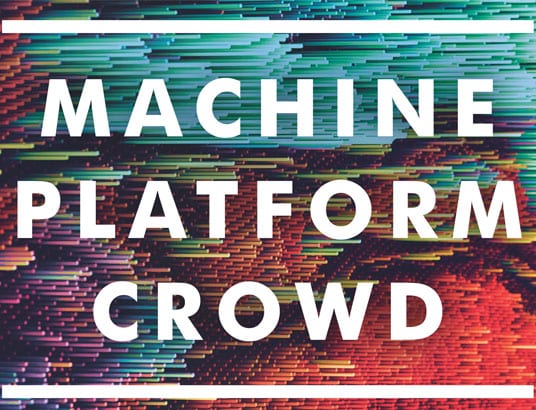- Posted on : January 10, 2019
-
- Industry : Corporate
- Type: Blog

Authored by Sunil Bhatia, CEO
With contributions from Kripal Datt, Sr. Consultant
Business leaders are aware of huge technology shifts underway directly impacting their industries, jobs, and livelihoods. Automation and AI are ubiquitous, and start-ups are dislodging industry giants. Social media has paved the way for grass roots ideas to flourish, leading to novel forms of innovation.
Andrew McAfee and Erik Brynjolfsson address these shifts in "Machine, Platform, Crowd". The authors predict these “Triple Technology” shifts:
- Artificial Intelligence (AI): Moving from man to machine.
- Products to Platforms: Platforms are a way for companies to create marketplaces, allowing both sides of the transaction to flourish.
- Core to Crowds: The “core” refers to centralized institutions and the “crowd” refers to the decentralized, self-organizing participants.
This book attempts to help business executives understand this changing technology landscape, and more importantly, how they can take advantage of these opportunities.
Below are key takeaways from the book.
“The Shatterer of Worlds”
While we all take the internet for granted today, business observers still stand in awe of the enormous financial change it unleashed among core segments of the world’s economy. The technology-driven industrial revolution and the rise of platforms have impacted the media, newspapers and music industries:
- The nationwide radio station revenue in the United States declined by almost 30% from $20 billion to $14 billion from the year 2000 to 2010, forcing many radio stations to sell themselves.
- By 2013 US newspapers revenue declined by 70% from 2007 to 2011, 13,400 jobs were cut in United State and worldwide, the sale of recorded music declined by 45% from $27 billion to $15 billion.
Some would say these enormous changes approximate the impact of the industrial revolution triggered by the invention of the steam engine by Thomas Newcomen at Dudley Castle coal mine in 1712.
Economic Drivers: Free, Perfect and Instant
There are three economic drivers of this revolution, say the authors: “free, perfect and instant economics of digital information goods in a time of pervasive networks”.
- Once something has been digitized, the marginal cost of making and distributing additional identical copies is zero.
- Perfect is, well, perfect. Once an original copy is created a digital copy is identical to the original digital version.
- Network goods can become more valuable as more people use them. The result is demand-side economies of scale, giving an advantage to bigger networks.
Craigslist, for example, grew rapidly from an email distribution list to a website, quickly reaching 700 local sites in seventy countries by 2014. Because of the favorable economics of platforms, Craigslist becomes the online destination for real estate listings, help-wanted ads and the like. Craig Newmark, the website’s founder, was able to grow his business to estimated profits of $25 million in 2008 while charging fees for only a few categories of ads, such as job ads or brokered apartment rentals in New York.
Network effect demand-side economics also benefit users. In 2014 Facebook paid $22 billion to acquire WhatsApp, a mobile application that allowed users to send messages through their data networks rather than SMS messages. This was a huge bonus for users who paid their mobile carrier for each SMS they sent or received. WhatsApp became so popular that even users with generous data plans switched so they could send and receive messages with the app’s 600 million monthly active users.
Paying complements and other smart strategies
What is a complement? Think cookies and milk. A complement contributes extra features to something else in such a way as to improve or emphasize its quality. Complements are necessary for a product sale and growth. When first iPhone was launched in 2007, for example, consumers had to rely on/work with pre-installed apps because Steve Jobs does not want to pollute iPhone integrity with outside developers app. In time, Apple opened its platform to include a variety of apps from myriad developers to satisfy customer preferences, and tremendous growth and innovation ensued. They also “complemented” the iPhone with freemium apps and Apps paired with products.
Demand for Apples’ product, the iPhone, went up as others provided complementary good.
Being smart = being different and early
Apple started developing iOS for the iPhone at the same time Google started on Android. Both succeeded in their own ways. Nokia/Microsoft/Blackberry, on the other hand, was reluctant for this change and fell way behind. This resulted in more than 20K layoffs, $8 billion in write-downs. Blackberry was down to $4 billion from $77 billion.
Software platforms must be strong and flexible to change.
The match game: why platforms excel
Platforms excel because they are important. The Digital platform is a set of tools built on modern cloud technology that makes the development of applications easy. Digital platforms are spreading to a variety of industries including transportation (Uber) and lodging (Airbnb) that pairs goods with services-- sometimes called O2O (online-to-offline) platforms. The book also mentions an availability-based exercise class (ClassPass), an industry where thus far we have seen relatively less disruption by platforms.
Revenue management is key here, turning capacity and perishable inventory into the best possible advantage. It takes years of hard work to create a sustainable platform, so companies either create their own or loan/use other existing platforms for a fee. O2O platforms are spreading quickly around the world.
Liquidity is necessary for business growth. It provides assurance that a transaction will happen without a huge price change. Tools and technology play a major role in achieving this. Uber, for example, uses heat map technology that shows the maximum amount of people in an area that maximize their chances of quickly getting a fare.
With platform success, do products have a prayer?
The key to many platforms is the power of two-sided networks, where decisions with one set of customers and products can profoundly affect demand by a different set of customers for a different set of customers. Platforms with two-sided networks can become multi sides networks.
Erik Brynjolfsson and Andrew McAfee
The most successful platform owner carefully creates value. iTunes, for example, is a great way to get music on an iPhone. The more artists that put their music on iTunes make the iPhone more attractive to buy. That’s is a nice example of a two-sided network. It also increases the value of the iPhone for other mobile apps—the more apps that are on the platform makes the iPhone more attractive to users.
Another way products can survive is if they are differentiated, and customers can be locked in. While Airbnb is a great way for tourists to find lodging, it’s less useful for the business traveler needs a bundle of services—laundry service, a place to take meetings, a gym, and a business.
To be successful companies must bring together products and platforms to transform their offerings.
Conclusion:
While Machine, Platform, Crowd explored the world that’s being created by emerging technologies, the overarching message of the book is that corporate leaders must capitalize on the opportunity to leverage technology to supplement both their organizations’ expertise as well as human judgment:
- They must learn to delegate more decision-making authority and judgment to algorithms and machines and find creative inspiration outside of their limited organizations.
- The best solutions will occur when mind and machines collaborate.
- The ability to work effectively with people’s emotional states and social drives will remain a deeply human skill for some time to come.” People will be critically important, just not always in the same roles they occupy today.
Infogain supports transformational technology initiatives at leading companies around the world, including consumer experience re-vamp, revolutionizing the use of knowledge in customer services, and leveraging robotic process automation to facilitate upscaling at rapidly growing companies. Contact a specialist here.
The following blog is based on the book Machine, Platform, Crowd: Machine, Platform, Crowd: Harnessing Our Digital Future by Andrew McAfee and Erik Brynjolfsson. The book has inspired many a conversation within Infogain, with our CEO Mr. Sunil Bhatia sharing his views here and encouraging us all to read this book.






